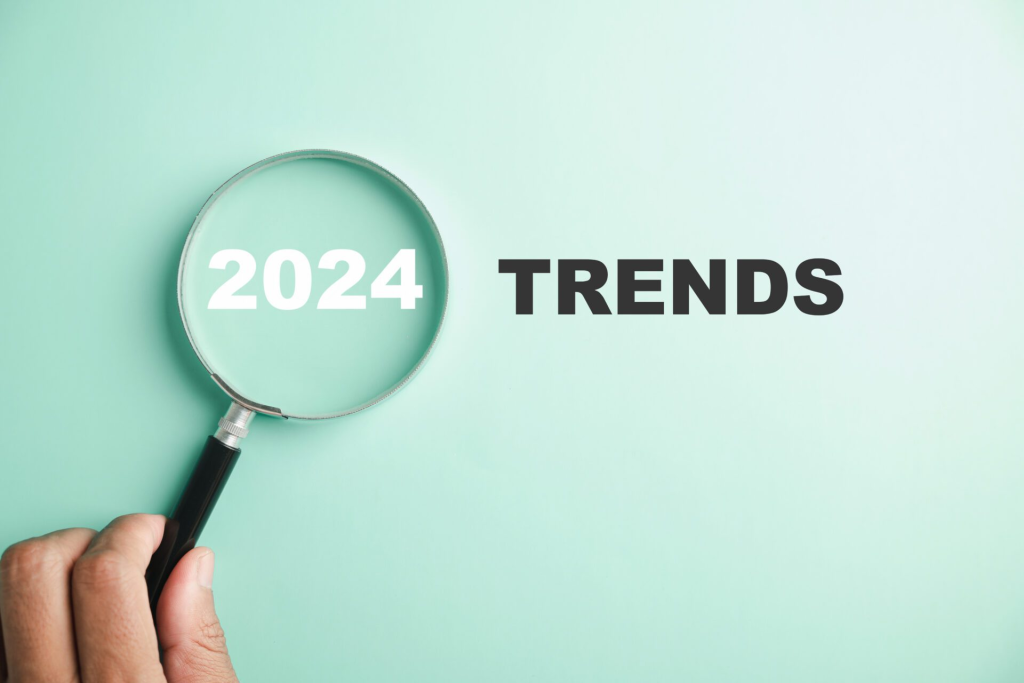
Have you ever wondered what the future of marketing holds? As we approach 2024, the marketing landscape is set to transform in exciting ways, offering new opportunities and challenges for businesses. In this blog post, we will delve into the top marketing trends for 2024 and how they can shape your strategies. By the end of this article, you’ll have a comprehensive understanding of these trends and actionable insights to stay ahead of the curve.
Introduction to Marketing Trends in 2024
As businesses continue to evolve in the digital age, so do the strategies they employ to engage customers. The year 2024 is no exception, bringing a host of new marketing trends driven by technological advancements and changing consumer behaviors. In this post, we’ll cover some of the most influential trends, including AI marketing automation, augmented reality (AR), virtual reality (VR), and more.
1- AI and Marketing Automation

AI continues to reshape the marketing landscape, and 2024 will be no different. From chatbots to predictive analytics, AI tools are becoming indispensable. According to Forbes, AI marketing automation is one of the top trends to watch (source).
AI-Powered Content Creation
AI can generate high-quality content in seconds. Tools like GPT-4 are already being used by marketers to create blog posts, social media updates, and even ad copy. This not only saves time but also ensures consistency in messaging.
Predictive Analytics
Predictive analytics allows marketers to forecast customer behavior and tailor their campaigns accordingly. For instance, Netflix uses predictive analytics to recommend shows based on viewing history, significantly improving user experience.
2- Augmented Reality (AR) and Virtual Reality (VR)

AR and VR are no longer just buzzwords. These technologies are becoming mainstream, offering immersive experiences that engage customers like never before.
Virtual Try-Ons
Brands like IKEA and Sephora are using AR to let customers try products virtually. This not only enhances the shopping experience but also reduces return rates.
VR Showrooms
Car manufacturers like Audi and BMW are leveraging VR to create virtual showrooms, allowing customers to explore car models from the comfort of their homes.
3- Hyper-Personalization

Personalization has always been a key component of effective marketing, but in 2024, we’re moving towards hyper-personalization.
Data-Driven Personalization
With the help of AI, marketers can now analyze vast amounts of data to create highly personalized experiences. According to HubSpot’s State of Marketing Report for 2024, 64% of marketers are already leveraging AI for personalization (source).
Real-Time Personalization
Real-time personalization allows brands to adjust their messaging based on real-time data. For example, Amazon uses real-time data to recommend products that customers are more likely to purchase.
4- Video Marketing

Video content continues to dominate the digital landscape. Short-form videos, in particular, are gaining traction.
Short-Form Videos
Platforms like TikTok and Instagram Reels have popularized short-form videos. These videos are engaging and easy to consume, making them a powerful tool for marketers.
Live Streaming
Live streaming offers a unique way to engage with audiences in real-time. Brands are using live streaming for product launches, Q&A sessions, and behind-the-scenes content.
5- Privacy and Data Protection

With growing concerns over data privacy, marketers must prioritize data protection in 2024.
Transparent Data Practices
Consumers are more aware of their data rights and expect brands to be transparent about how their data is used. Implementing transparent data practices can build trust and loyalty.
Compliance with Regulations
Marketers must stay updated with data protection regulations like GDPR and CCPA. Non-compliance can result in hefty fines and damage to brand reputation.
6- Customer Experience (CX)

Customer experience is at the heart of successful marketing strategies. A positive CX can drive customer loyalty and advocacy.
Omnichannel Experience
Providing a seamless experience across multiple channels is crucial. According to Gartner, enhancing the omnichannel experience is one of the top priorities for CMOs in 2024 (source).
Personal Touch
Adding a personal touch to customer interactions can significantly improve CX. For instance, personalized emails and customer service can make customers feel valued.
7- Social Media SEO

Social media platforms are evolving into powerful search engines. Optimizing for social media SEO is essential in 2024.
Hashtag Optimization
Using relevant hashtags can increase the discoverability of your content. Tools like Hootsuite can help you identify trending hashtags in your niche.
Social Media Profiles
Optimizing your social media profiles with keywords can improve your visibility. Ensure your profiles are complete and include links to your website.
8- Sustainability in Marketing

Consumers are increasingly conscious of the environmental impact of their purchases. Incorporating sustainability into your marketing strategy can resonate with eco-conscious consumers.
Eco-Friendly Practices
Implementing eco-friendly practices, such as reducing packaging waste and promoting sustainable products, can enhance your brand image.
Cause Marketing
Partnering with environmental organizations and promoting sustainability initiatives can strengthen your brand’s commitment to sustainability.
FAQs
What will marketing look like in 2025?
By 2025, AI will play a significant role in digital marketing. AI-powered content creation, personalized customer experiences, and data-driven decision-making will become standard practices (source).
What are the CMO trends for 2024?
In 2024, CMOs are focusing on new AI technology, changing talent, customer acquisition strategies, and increasing cross-functional collaboration. These trends are shaping how organizations lead marketing success (source).
What do consumers want in 2024?
Consumers in 2024 prioritize customer feedback, branding, personality, 24/7 support, omnichannel shopping opportunities, purchasing power, health and wellness, personalization, and sustainability (source).
How can businesses adapt to marketing trends in 2024?
Businesses can adapt to marketing trends in 2024 by embracing AI, focusing on personalization, enhancing CX, optimizing for social media SEO, and incorporating sustainability into their strategies. Staying updated with industry trends and continuously innovating will be key.
Conclusion
Marketing trends for 2024 are set to revolutionize the industry. By embracing AI, AR/VR, hyper-personalization, and focusing on customer experience and sustainability, businesses can stay ahead of the curve. Remember, staying updated with trends and continuously innovating is essential for success.
Thank you for taking the time to read this far. If you would like to know more about this subject, please contact us.




